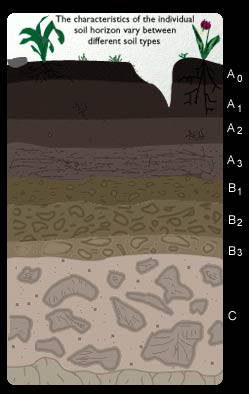The Earth Contents
5. Soils
There are a number of layers, or horizons, in all soils; the A horizon is closest to the surface.

The A horizon, contains the most organic matter. It is where much of this organic matter is broken down into constituent minerals, and is consequently extremely active biologically. It includes a surface layer (the A0 horizon) which is mostly litter made from fallen leaves and other plant materials. Beneath this is a zone with high organic content (or humus) called the A1 horizon. Deeper still is found the A2 horizon which is the most active zone for the downward movement of clays and dissolved minerals. The A3 horizon is a transition zone to the B horizon.
The B horizon is typically an area of accumulation of the materials transported downwards from the A horizon. As with the latter, the B horizon contains a number of zones. It contains less organic matter and is less active biologically. Below this layer, the C horizon is a transition zone between soil and underlying rock. It is much less altered than the horizons above it and is much less biologically active.
What are the main characteristics of the three horizons in a generalised soil profile?